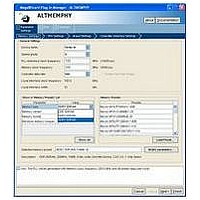IPR-HPMCII Altera, IPR-HPMCII Datasheet - Page 40

IPR-HPMCII
Manufacturer Part Number
IPR-HPMCII
Description
IP CORE Renewal Of IP-HPMCII
Manufacturer
Altera
Datasheet
1.IP-HPMCII.pdf
(176 pages)
Specifications of IPR-HPMCII
Software Application
IP CORE, Memory Controllers, SDRAM
Supported Families
Arria II GX, HardCopy III, Stratix III, Stratix IV
Core Architecture
FPGA
Core Sub-architecture
Arria, HardCopy, Stratix
Rohs Compliant
NA
Lead Free Status / RoHS Status
na
- Current page: 40 of 176
- Download datasheet (4Mb)
3–12
Table 3–6. ALTMEMPHY PHY Settings (Part 2 of 2)
External Memory Interface Handbook Volume 3
Section II. DDR3 SDRAM Controller with ALTMEMPHY IP User Guide
Instantiate DLL
externally
Enable dynamic parallel
on-chip termination
(OCT)
Clock phase
Dedicated clock phase
Board skew
Autocalibration
simulation options
Parameter Name
Applicable Device Families
All supported device
families.
Stratix III and Stratix IV
Stratix III and Stratix IV
All supported device
families except Arria II GX
and Stratix IV devices
All supported device
families
Arria II GX
Use this option with Stratix III, Stratix IV, HardCopy III, or
HardCopy IV devices, if you want to apply a non-standard phase
shift to the DQS capture clock. The ALTMEMPHY DLL offsetting I/O
can then be connected to the external DLL and the Offset Control
Block.
This option provides I/O impedance matching and termination
capabilities. The ALTMEMPHY megafunction enables parallel
termination during reads and series termination during writes with
this option checked. Only applicable for DDR3 SDRAM interfaces
where DQ and DQS are bidirectional. Using the dynamic
termination requires that you use the OCT calibration block, which
may impose a restriction on your DQS/DQ pin placements
depending on your R
For more information, refer to either the
Interfaces in Stratix III Devices
Device Handbook or the
Devices
Adjusting the address and command phase can improve the
address and command setup and hold margins at the memory
device to compensate for the propagation delays that vary with
different loadings. You have a choice of 0°, 90°, 180°, and 270°,
based on the rising and falling edge of the phy_clk and
write_clk signals. In Stratix IV and Stratix III devices, the clock
phase is set to dedicated.
When you use a dedicated PLL output for address and command,
you can choose any legal PLL phase shift to improve setup and
hold for the address and command signals. You can set this value
to between 180° and 359° (the default is 240°). However, generally
PHY timing requires a value of greater than 240° for half-rate
designs.
Maximum skew across any two memory interface signals for the
whole interface from the FPGA to the memory (either a discrete
memory device or a DIMM). This parameter includes all types of
signals (data, strobe, clock, address, and command signals). You
need to input the worst-case skew, whether it is within a DQS/DQ
group, or across all groups, or across the address and command
and clocks signals. This parameter generates the timing constraints
in the .sdc file.
Choose between Full Calibration (long simulation time), Quick
Calibration, or Skip Calibration.
For more information, refer to the
the External Memory Interface Handbook.
chapter in volume 1 of the Stratix IV Device Handbook.
UP
/R
External Memory Interfaces in Stratix IV
DN
Description
pin locations.
chapter in volume 1 of the Stratix III
Simulation
December 2010 Altera Corporation
ALTMEMPHY Parameter Settings
External Memory
Chapter 3: Parameter Settings
section in volume 4 of
Related parts for IPR-HPMCII
Image
Part Number
Description
Manufacturer
Datasheet
Request
R

Part Number:
Description:
IP NIOS II MEGACORE RENEW
Manufacturer:
Altera
Datasheet:

Part Number:
Description:
IP CORE Renewal Of IP-XAUIPCS
Manufacturer:
Altera
Datasheet:

Part Number:
Description:
IP CORE Renewal Of IP-10GETHERNET
Manufacturer:
Altera
Datasheet:

Part Number:
Description:
IP CORE Renewal Of IP-ASI
Manufacturer:
Altera
Datasheet:

Part Number:
Description:
IP CORE Renewal Of IP-CIC
Manufacturer:
Altera
Datasheet:

Part Number:
Description:
IP CORE Renewal Of IP-CRC
Manufacturer:
Altera
Datasheet:

Part Number:
Description:
IP CORE Renewal Of IP-ED8B10B
Manufacturer:
Altera
Datasheet:

Part Number:
Description:
CPLD, EP610 Family, ECMOS Process, 300 Gates, 16 Macro Cells, 16 Reg., 16 User I/Os, 5V Supply, 35 Speed Grade, 24DIP
Manufacturer:
Altera Corporation
Datasheet:

Part Number:
Description:
CPLD, EP610 Family, ECMOS Process, 300 Gates, 16 Macro Cells, 16 Reg., 16 User I/Os, 5V Supply, 15 Speed Grade, 24DIP
Manufacturer:
Altera Corporation
Datasheet:

Part Number:
Description:
Manufacturer:
Altera Corporation
Datasheet:










